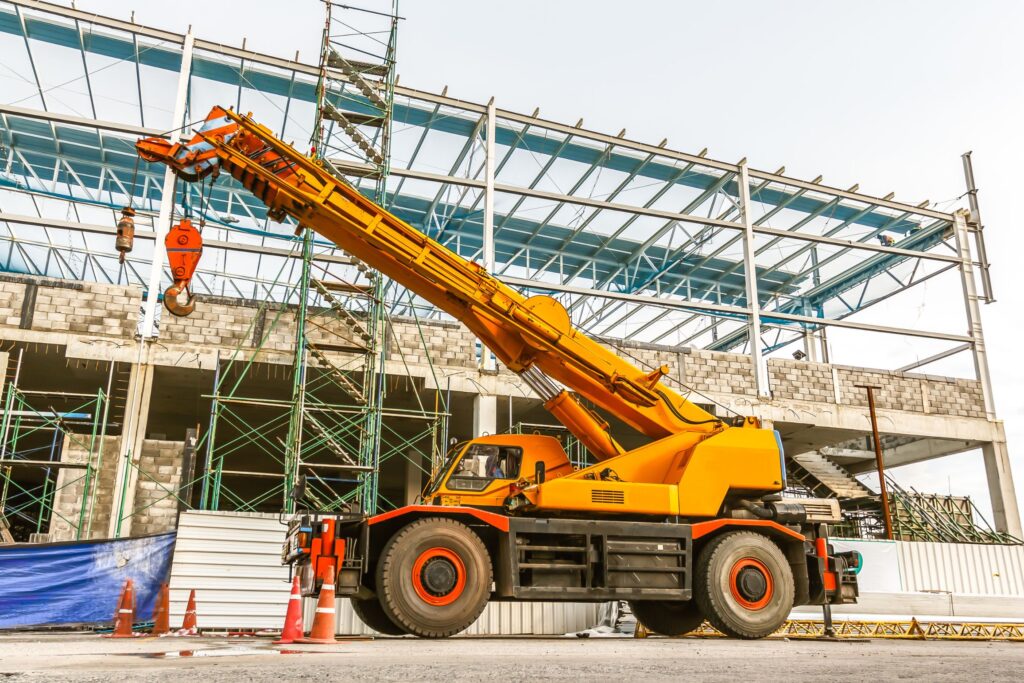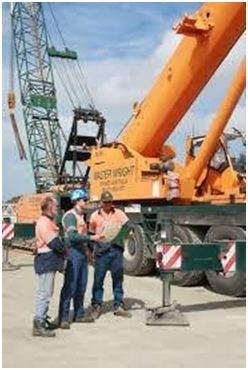- Competent Person Definition: Whose Job Is It To Inspect Cranes at the Jobsite?
- Record Keeping and Documentation
- What needs to be documented?
- Mobile Cranes
- Crawler Cranes
- All-Terrain Mobile Cranes
- Who Can Perform Mobile Crane Inspections?
- Mobile Crane Inspection Process
- Mobile Crane Operator Training
- 3rd Party Crane Inspector Benefits
- How Much Do Crane Inspections Cost?
- Operating the Crane Safely
- Common Hazards and How to Avoid Them
- Elevating Your Crane Inspection Program
- Where Can I Get Mobile Crane Inspection Services?

The Importance of Mobile Crane Inspections
Mobile cranes are the workhorses of construction sites, but their daily use can lead to wear and tear, potentially causing accidents and injuries. To prevent these issues, regular and professional crane inspections are crucial for identifying potential problems before they occur. These inspections keep everyone safe and ensure the crane functions optimally.
Regular inspections offer a multitude of benefits. First and foremost, they play a vital role in accident prevention. By catching minor issues before they escalate into major breakdowns or accidents, inspections protect workers and property from harm. Inspections also enhance safety by identifying and addressing potential hazards, creating a safer work environment for everyone on the job site. Finally, regular inspections help ensure the crane is functioning properly for maximum efficiency and productivity. A well-maintained crane experiences fewer breakdowns, delays, and costly repairs, ultimately leading to a more productive work site.
Read more about the newest OSHA Crane Compliance Directives on our blog.
OSHA Crane Inspection Requirements, Compliance and Regulations
Mobile cranes play a pivotal role in enhancing lifting operations across diverse work sites, facilitating efficiency and productivity. However, a concerning trend persists: many crane operators and their employers demonstrate inadequate competence in safely executing crane operations. This deficiency often stems from a lack of training and familiarity with the regulations, protocols, and safety procedures mandated by authoritative bodies such as OSHA (Occupational Safety and Health Administration).
The Occupational Safety and Health Administration (OSHA) enforces a set of regulations to ensure the safety of workers operating or working near cranes. These regulations aim to minimize accidents and injuries by mandating thorough and regular inspections.Here’s a breakdown of OSHA’s key crane inspection requirements for compliance:
Competent Person Definition: Whose Job Is It To Inspect Cranes at the Jobsite?

While OSHA allows employers to designate a qualified employee as a competent person for annual inspections, the definition of “competent person” is crucial [4]. An OSHA interpretation clarifies that a competent person must have “knowledge and understanding of crane operation, capacity limitations, and the applicable OSHA standards.” This emphasizes the importance of ensuring the designated inspector possesses the necessary expertise to conduct a thorough and effective inspection.
Engaging a third-party inspector for crane inspections offers several benefits, including impartial reporting, specialized expertise, cost-saving recommendations, enhanced confidence through credentials, and adherence to state regulations. TET, a nationally recognized, OSHA-compliant organization, stands ready to provide third-party inspection services for mobile cranes and heavy vehicles, ensuring thorough and meticulous assessments.
Record Keeping and Documentation
Employers are obligated to maintain documentation of all crane inspections. These records should detail the dates of inspections, the identity of the inspector performing the inspection, and any findings or corrective actions taken.
Maintaining thorough and readily available documentation of these inspections acts as a safety net, providing a clear history of the crane’s condition and any identified issues.
What needs to be documented?
OSHA regulations mandate that employers retain specific details from crane inspections. These details include:
- Dates of Inspections: Keeping a clear record of when inspections were conducted helps maintain a consistent schedule and avoid missed inspections.
- Inspector Identification: Documenting the inspector’s name ensures accountability and demonstrates the inspector’s qualifications.
- Inspection Findings: Any issues identified during the inspection should be clearly documented. This allows for proper follow-up and ensures no critical details are overlooked.
- Corrective Actions: Record the actions taken to address any problems identified during the inspection. This demonstrates a commitment to resolving safety concerns.
Pre-Inspection and Collaboration:
Prior to a formal inspection, a qualified inspector will typically:
- Review Past Records: Past inspection and maintenance records provide valuable insights into the crane’s overall health and any recurring issues.
- Consult the Manual: The manufacturer’s operator manual serves as a crucial reference for proper operation, capacity limitations, and inspection procedures. OSHA mandates that a copy of the manual is always present in the crane cab for easy access by the operator.
- Discuss Capacity and Restrictions: Open communication with the crane operator allows the inspector to understand the crane’s usage, any site-specific limitations due to ongoing activities, and potential functional limitations of the crane itself.
Record Retention Requirements:
OSHA regulations require employers to retain specific inspection records within the crane itself. These records should detail any deficiencies found and the subsequent corrective actions taken. While indefinitely storing all records may be a best practice, OSHA acknowledges that keeping the last two inspection and maintenance records fulfills the intent of the standards.
By maintaining comprehensive and accessible crane inspection records, employers demonstrate their commitment to safety and establish a clear history of the crane’s condition. This not only safeguards workers but also serves as valuable evidence in case of any incidents.
Types of Mobile Crane Inspections
Mobile cranes come in various configurations, each with specific strengths and uses. To ensure their safety and functionality, all cranes require regular inspections. Here’s a breakdown of common crane inspections, categorized by type and application:
Mobile Cranes
Crawler Cranes
These unique mobile cranes utilize tracks for superior traction on uneven surfaces. While highly maneuverable on site, they require transport between jobs. Crawler crane inspections follow the same protocols as other mobile cranes.